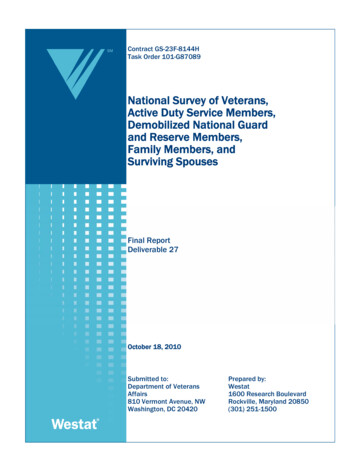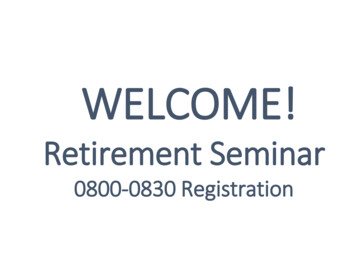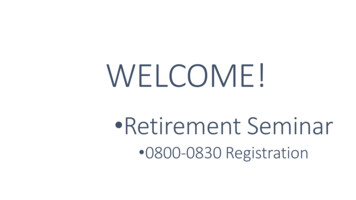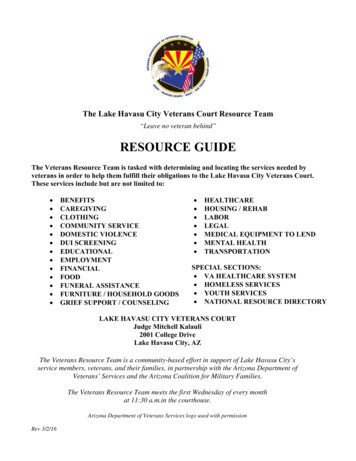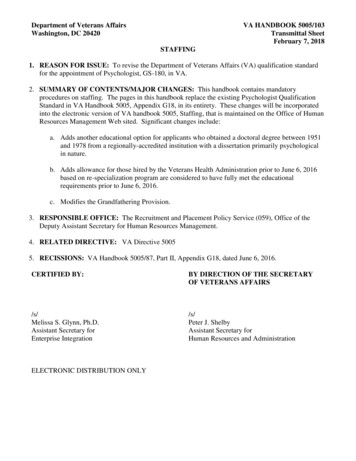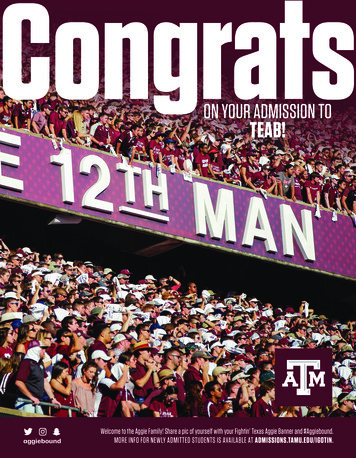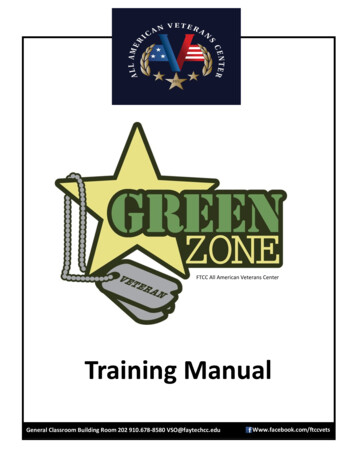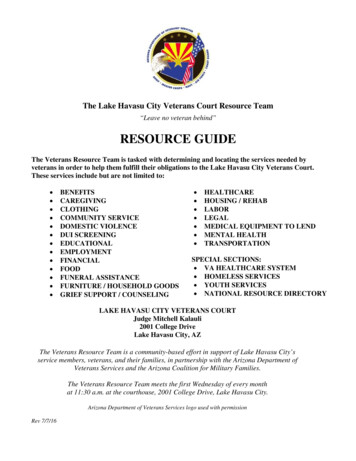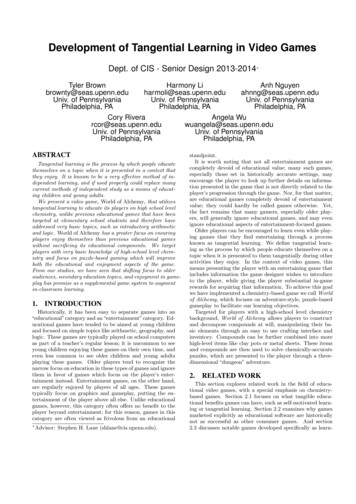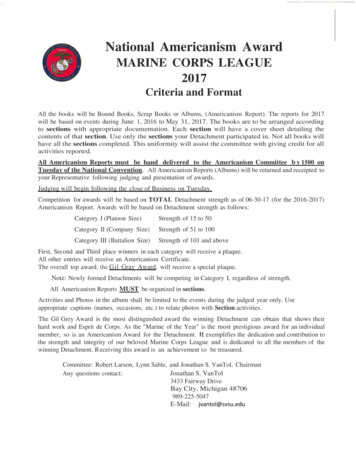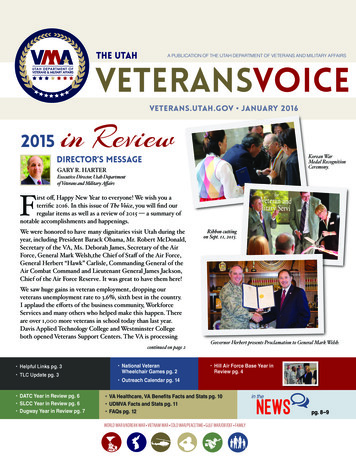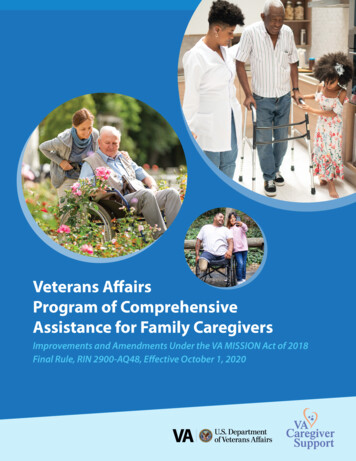
Transcription
Veterans A airsProgram of ComprehensiveAssistance for Family CaregiversImprovements and Amendments Under the VA MISSION Act of 2018Final Rule, RIN 2900-AQ48, E ective October 1, 2020
IntroductionProgram of Comprehensive Assistancefor Family CaregiversTable of ContentsIntroduction01The U.S. Department of Veterans Affairs (VA) Program of ComprehensiveAssistance for Family Caregivers (PCAFC) offers enhanced clinical support forcaregivers of eligible Veterans who are seriously injured. These changes are basedon the new “Program of Comprehensive Assistance for Family Caregivers (PCAFC)Improvements and Amendments Under the VA MISSION Act of 2018” Final Rule,RIN 2900-AQ48, effective October 1, 2020.Expansion Overview02These changes include:Eligibility Requirements04Expanding eligibility for the PCAFCApplication Process06Monthly Stipend for Primary Family Caregivers10Offering legal and financial services for designated PrimaryFamily Caregivers of eligible Veterans in 2021Legacy Participants12Making other changes affecting program eligibility and VA’s evaluation ofPCAFC applicationsWho qualifies: Veterans who incurred or aggravated a serious injury (including aserious illness) in the line of duty in the active military, naval, or air service on orafter September 11, 2001, or on or before May 7, 1975.This document released: October 21, 20201
Expansion OverviewPrimary Family CaregiverBenefitsBenefits for Primary Family Caregivers include:Education and trainingAccess to healthcare insurance(If caregiver is otherwise uninsured)Mental health counselingWho should consider applying to the Program of Comprehensive Assistancefor Family Caregivers?1A Veteran who has a single or combined service-connected disability rating of 70% or more, and2Who is in need of in-person personal care services for a minimum of six (6) continuous monthsbased on either: An inability to perform an activity of daily living (ADL) each time the activity is performed, or A need for supervision, protection, or instruction, which means a functional impairment thatdirectly impacts his/her ability to maintain his or her personal safety, on a daily basis.Your Caregiver Support Coordinator can provide you with more information. They will help you everystep of the way! There are seven eligibility requirements. Please see the Eligibility Requirements sectionin this document for details.Financial stipendRespite careWellness ContactsTravel and per diem compensation(when traveling for a Veteran’s VAhealthcare appointment)Major Expansion Changes –Big Wins for Veterans!Previously: VA required a connectionbetween the need for personal careservices and the qualifying serious injury.Expansion Changes: In addition toexpanding to pre-1975 era Veterans, theenhanced PCAFC eliminates the need for aconnection between personal care servicesand the qualifying serious injury. It alsoredefines serious injury to now include anyservice-connected disability — regardlessof whether it resulted from an injury,illness or disease. Both changes greatlyexpand program eligibility.Why This is Important: In most cases, theeligible Veteran has multiple conditionsthat may warrant a need for personalcare services. A Veteran’s needs maybe so complex that it can be difficult todetermine what specific condition, outof many, causes the need for personalcare services.PCAFC ApplicationVeterans and caregivers may apply for PCAFC in three ways:1Access the online application: siveassistance-for-family-caregivers2Visit www.caregiver.va.gov and download VA Form 10-10CG. Mail the completed form to: Programof Comprehensive Assistance for Family Caregivers Health Eligibility Center: 2957 Clairmont Road,NE, Suite 200 Atlanta, GA 30329-1647Apply in person through local Veterans Affairs Medical Center (VAMC) Caregiver Support Coordinator2 Veterans Affairs Program of Comprehensive Assistance for Family Caregivers3
Eligibility RequirementsStipend Levels:Veteran Eligibility Requirements:The Veteran must have a serious injury, whichis a single or combined service-connecteddisability rating of 70% or more, and meet thefollowing eligibility requirements to participatein the Program of Comprehensive Assistance forFamily Caregivers:1The individual is either:5Personal care services that would beprovided by the Family Caregiver will notbe simultaneously and regularly providedby or through another individual or entity.6The individual receives care at home or willdo so if VA designates a Family Caregiver.7The individual receives ongoing care froma Primary Care Team or will do so if VAdesignates a Family Caregiver. A Veteran; or A member of the Armed Forcesundergoing a medical discharge fromthe Armed Forces.2The individual has a serious injury(including serious illness) incurred oraggravated in the line of duty in the activemilitary, naval, or air service: On or after September 11, 2001; or On or before May 7, 1975; orThe individual is in need of in-personpersonal care services for a minimum of six(6) continuous months based on any one ofthe following: An inability to perform an activity ofdaily living; orFor you to be eligible to be a Family Caregiveryou must:1Be at least 18 years of age.2Be either: The eligible Veteran’s spouse, son,daughter, parent, stepfamily member,or extended family member; or Someone who lives with the eligibleVeteran full-time or will do so ifdesignated as a Family Caregiver.3Be initially assessed by VA as being able tocomplete caregiver education and training.4Complete caregiver training anddemonstrate the ability to carry outthe specific personal care services,core competencies, and additional carerequirements. A need for supervision, protection,or instruction.4It is in the best interest of the individual toparticipate in the program.12Family CaregiverEligibility Requirements Effective October 1, 2022, the programwill expand to include those individualswho served after May 7, 1975, andbefore September 1, 2001.3As an eligible Primary Family Caregiver, you mayqualify to receive a monthly stipend, which ispaid at one of two levels. Here are the details:In addition, there must be no determination byVA of abuse or neglect of the eligible Veteran bythe caregiver4 Veterans Affairs Program of Comprehensive Assistance for Family Caregivers3Inability to Perform Activity of Daily Living (ADL)The “inability to perform an ADL” meansthe Veteran or service member requirespersonal care services each time he orshe completes one or more of the ADLslisted below:If a Veteran meets all seven eligibilityrequirements (listed above), then VA mustdetermine whether the Veteran is “unableto self-sustain in the community.” Dressing or undressing oneselfLevel One: If VA determines that aVeteran is not “unable to self-sustain inthe community,” the designated PrimaryFamily Caregiver will receive the lowerlevel stipend payment. Adjusting any special prosthetic ororthopedic appliance, that by reasonof the particular disability cannot bedone without assistance (this does notinclude the adjustment of appliancesthat nondisabled persons would beunable to adjust without aid, such assupports, belts, lacing at the back, etc.)Level Two: If VA determines the Veteranis “unable to self-sustain in thecommunity” the designated PrimaryFamily Caregiver will receive the higherlevel stipend payment.Unable to Self-Sustain in the Community“Unable to self-sustain in the community”means that an eligible Veteran either: Requires personal care services eachtime he or she completes three ormore of the seven activities of dailyliving (ADL) listed in the definition ofan inability to perform an activity ofdaily living in this section, and is fullydependent on a caregiver to completesuch ADLs; or Bathing Grooming oneself in order to keeponeself clean and presentable Toileting or attending to toileting Feeding oneself due to loss ofcoordination of upper extremities,extreme weakness, inability to swallow,or the need for a non-oral means ofnutrition Mobility (walking, going up stairs,transferring from bed to chair, etc.)Requiring assistance with an ADL onlysome of the time does not meet thedefinition of an “inability to performan ADL.” Has a need for supervision, protection,or instruction on a continuous basis.A Need for Supervision, Protection,or InstructionA “need for supervision, protection, orinstruction” means the Veteran or servicemember has a functional impairment thatdirectly impacts their ability to maintain hisor her personal safety on a daily basis5
Application ProcessProgram of Comprehensive Assistance for Family Caregivers (PCAFC)Application Process45Where:What: An assessment to collect specificinformation about each caregiver. Access the online application: sive-assistancefor-family-caregivers/ Access and download the applicationfor the PCAFC. VA Form 10-10CG6Who: A member of the Local CSP Teamconducts the application intake withthe Veteran and each Family Caregiverapplicant.What: Review completed PCAFCapplication.Where: In person, by telephone, orvia VA Video Connect.6 Veterans Affairs Program of Comprehensive Assistance for Family CaregiversVeteran AssessmentWho: A member of the Local CSP Teamconducts a clinical assessment withthe Veteran.What: Clinical information about theVeteran, including the caregiver’s input oncare needsWhere: In person, by telephone, or via VAVideo Connect.Final Application ReviewWho: The CSP Centralized Eligibility andAppeals Team (CEAT).Initial Application ReviewWhere: Internal to VA.When: Internal to VA.39What: Assessment reviewed and finaleligibility determined.What: A review of assessments andmedical records.If the Veteran and at least one caregiverapplicant meet the specific eligibilityrequirements, the following steps will occur Where: In the Veteran’s home.Where: In person, by telephone, or via VAVideo Connect.Who: The CSP Centralized Eligibility andAppeals Team (CEAT) conducts a review ofthe application. Locate and contact the CaregiverSupport Program Team at the nearestVA health care facility. A CSP Teamlocator is available at: http://www.caregiver.va.gov/.Application IntakeCaregiver AssessmentWho: A local CSP Team conducts aclinical assessment with each FamilyCaregiver applicant.What: Fill out the application or VA canhelp with the form.2What: Assessment to determine the wellbeing of the Veteran and Family Caregiverapplicant(s), as well as the Family Caregiverapplicant(s)’ competence to providepersonal care services at theVeteran’s home.Where: In person or via VA Video Connect.Who: Veteran and caregiver completethe application.Home-Care AssessmentWho: The CSP Clinical Assessorconducts the Home-Care Assessmentwith the Veteran and each FamilyCaregiver applicant.What: Veteran Functional AssessmentInstrument, which assesses the Veteran’sfunctional abilities.Application Submission Call the National Caregiver SupportLine at: 1-855-260-3274.8Who: The CSP Clinical Assessor completesthe Functional Assessment instrument withthe Veteran.The local Caregiver Support Program (CSP) Team coordinates and communicates with the Veteran andeach caregiver applying for the PCAFC throughout the following application process. The step-by-stepapplication process is outlined below.1Veteran Functional Assessment10 NotificationWithin 90 days of the application beingreceived by VA, a member of the CSPTeam will call the Veteran and FamilyCaregiver applicant(s) to notify them ofthe determination. An official letter willalso be mailed.Steps 7 through 10 are followed only whenthe CEAT determines that the Veteran andFamily Caregiver will continue with theapplication process.7Caregiver TrainingWho: Each Family Caregiver applicantcompletes caregiver training.What: Caregiver Core Curriculum.Where: Caregiver training is completedonline or via workbook.7
Application ProcessEligibility Decision Within 90 Days of Application ReceiptApplication Process Steps for the Program of Comprehensive Assistance forFamily Caregivers gibleReferred tothe Programof GeneralCaregiverSupportServices andother VAservices; andinformed of theprocess to file aclinical appealColor Key:Veteran ActionVeteran & VA nFunctionalAssessmentInstrumentPrimary CareCollaboration,to the extentpracticable, willalso occur duringthis time NotEligibleReferred tothe Programof GeneralCaregiverSupport Servicesand other VAservices; andinformed of theprocess to file aclinical eviewNotEligibleNotificationof Denial10PotentiallyEligibleNotificationof ApprovalEligibleReferred toPCAFC benefitsand supportsReferred tothe Programof GeneralCaregiverSupportServices andother VAservices; andinformed of theprocess to file aclinical appealVA Action8 Veterans Affairs Program of Comprehensive Assistance for Family Caregivers9
Monthly Stipend for Primary Family CaregiversStipend Payment: Two LevelsPCAFC Monthly StipendCaregivers play an important role in the healthand well-being of Veterans.The U.S. Department of Veterans Affairs (VA)offers a number of services to support FamilyCaregivers including a monthly stipend toPrimary Family Caregivers of Veterans withmoderate and severe needs.A stipend is defined as a monthly financialpayment provided to a Primary FamilyCaregiver of an eligible Veteran.Monthly Stipend RateVA bases stipend payments on the definitionof “monthly stipend rate,” which means theOffice of Personnel Management (OPM) GeneralSchedule (GS) Annual Rate for Grade 4, Step1, based on the locality pay area in which theeligible Veteran resides, divided by 12.Questions About RecurringPayments? VA will apply a specific percentage ofthe monthly stipend rate based on theamount and degree of personal careservices provided to the eligible Veteranby the Primary Family Caregiver.The VHA Office of Community Care (VHA OCC)issues the recurring monthly payments andprocesses all updates related to the stipend. Youmay contact VHA OCC for information on theprocessing activities for the stipend benefit via: The amount and degree of personal careservices is divided into two levels. Thedistinction between the two levels is based onif the Veteran is determined to be unable toself-sustain in the community. Mail: VHA Office of Community CareCaregiver Support ProgramPO Box 460637Denver, CO 80246-0637Level 1: For an eligible Veteran who isdetermined not to be “unable to self-sustain”in the community, the Primary FamilyCaregiver’s stipend amount will be 62.5% ofthe monthly stipend rate.For Legacy Participants:If you were participating in PCAFC priorto October 1, 2020, please see theLegacy Participants section in thisdocument for details. Phone: Call the Caregiver Support Lineat 1-855-260-3274 - Toll free Expanded Hours Monday-Friday, 8:00a.m. to 10 p.m. ET; Saturday 8:00 a.m.to 5:00 p.m. ET For example the GS rate at Grade 4,Step 1, in Dallas, Texas, for 2020 is 33,638 annually. Email: Follow the directions for submittingemail via IRIS at https://iris.custhelp.com/app/ask Thus, the monthly stipend amount for aPrimary Family Caregiver of an eligibleVeteran in Dallas, Texas, at this rate(62.5%) of 33,638 will be approximately 1,751.98. Web: https://www.va.gov/communitycare/Level 2: For an eligible Veteran who isdetermined to be unable to self-sustain in thecommunity, the Primary Family Caregiver’sstipend amount will be 100% of the monthlystipend rate. For example the GS rate at grade 4,step 1, in Dallas, Texas, for 2020 is 33,638 annually. The 2020 monthly stipend amount fora Primary Family Caregiver of aneligible Veteran in Dallas, Texas, at thisrate (100%) of 33,638 will beapproximately 2,803.17.10 Veterans Affairs Program of Comprehensive Assistance for Family Caregivers11
Legacy ParticipantsLegacy Participants: Frequently Asked Questions and AnswersQ1. Why do I need to be reassessed?A1. VA is making changes to improve and expandthe Program of Comprehensive Assistance forFamily Caregivers (PCAFC), including changesto eligibility criteria. Accordingly, all LegacyParticipants need to be reassessed toensure new eligibility criteria are met forcontinued enrollment.Q2. Do I need to complete a new application?A2. No. As a Legacy Participant, you do not needto complete a new application.Q3. When will I be reassessed?Who is a Legacy Participant?If you and your Family Caregiver(s) were approved and designated by VA as eligible for PCAFC beforeOctober 1, 2020, you are considered a “Legacy Participant.”What Do I Need to Do?No immediate action is required if you want to stay in the PCAFC.VA will schedule a reassessment appointment between October 1, 2020 and September 30, 2021 toreassess your continued eligibility and care needs. No matter when your reassessment occurs withinthat one year transitional period, you maintain your automatic eligibility through September 30, 2021.Is My Stipend Going to Change Due to a Reassessment?For Legacy Participants who meet the neweligibility requirements and the reassessmentresults in: A higher stipend amount, then the increasewill take effect immediately with retroactivepayment to October 1, 2020.For Legacy Participants who do not meet thenew eligibility requirements (and who are notdischarged or revoked on another basis), theircurrent stipend amount will continue for thetransitional period. A lower stipend amount, then the currentstipend amount remains through theduration of the transitional period.12 Veterans Affairs Program of Comprehensive Assistance for Family CaregiversA3. Between October 1, 2020, and September30, 2021, if you wish to stay in PCAFC, anappointment will be scheduled to reassess yourcontinued eligibility and care needs. No matterwhen your reassessment occurs within thatyear, you maintain your automatic eligibility forone year – through September 30, 2021. TheCaregiver Support Coordinator will contact youto participate in the required reassessment.Q4. Do I have to come to the medical centerduring COVID-19 pandemic to be reassessed?A4. No. Veteran safety is our utmost priority.During the COVID-19 pandemic, assessments willbe conducted by local staff either at VA medicalcenters or by virtual telehealth visits while theVeteran and caregiver are at home.Q7. How will I find out about my reassessmentdetermination?A7. You will receive a phone call from yourCaregiver Support Coordinator, followedby a letter.Q8. What will happen if I’m discharged fromthe program?A8. VA will provide advanced notice of itsdecision by October 1, 2021. Legacy Participantswill stop receiving payments no earlier thanDecember 1, 2021. In addition, the FamilyCaregiver will receive 90 days of extendedbenefits following the date of discharge.Q9. If I disagree with the decision, can I makean appeal?A9. Yes. If you disagree with a decision underPCAFC, you have the right to appeal. Pleasecontact the Patient Advocate at your local VAmedical center to discuss the appeal process.Your Caregiver Support Coordinator is alsoavailable if you have additional questions.Q10. Are there any other programs to help me?A10. Additional services are available throughour Program of General Caregiver SupportServices (PGCSS), as well as access to a CaregiverSupport Coordinator at every VA medical center.Information on available resources is located onthe caregiver website at www.caregiver.va.gov.Q5. Who will decide if I meet the criteria?A5. Once your reassessment is completed, aCentralized Eligibility and Appeals Team willreview and make a determination regarding youreligibility beyond September 30, 2021.Q6. How long after my reassessment will it takefor a determination to be made?A6. The determination will be made within 45days of the reassessment.13
14 Veterans Affairs Program of Comprehensive Assistance for Family Caregivers15
How to Contact a Caregiver Support CoordinatorVeterans and caregivers can find their local Caregiver Support Coordinator by:Toll Free: Calling the Caregiver Support Line at 1-855-260-3274 (Expanded Hours MondayFriday, 8:00 a.m. to 10 p.m. ET; Saturday 8:00 a.m. to 5:00 p.m. ET)Using the Caregiver Support Coordinator locator tool atwww.caregiver.va.gov/support/New CSC Page.aspOnline application available .va.gov
do so if VA designates a Family Caregiver. The individual receives ongoing care from a Primary Care Team or will do so if VA designates a Family Caregiver. Family Caregiver Eligibility Requirements . For you to be eligible to be a Family Caregiver you must: 1 2 Be at least 18 years
